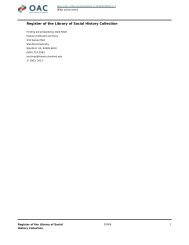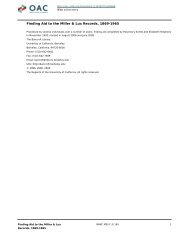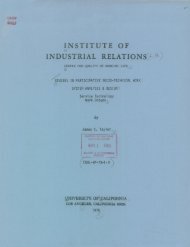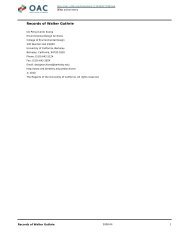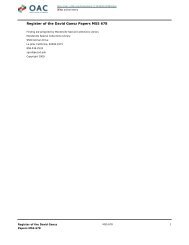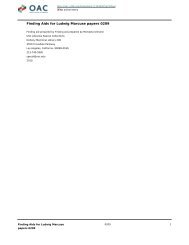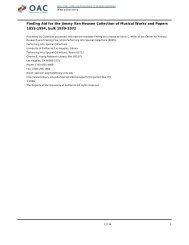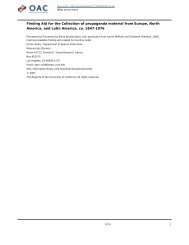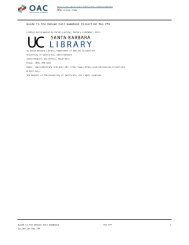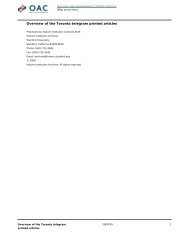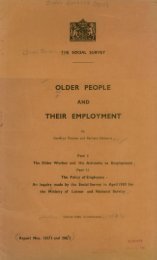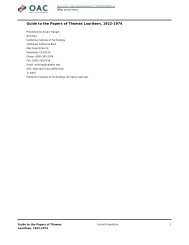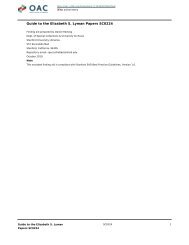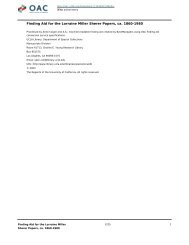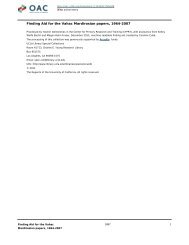Otis R. "Dock" Marston Papers - Calisphere
Otis R. "Dock" Marston Papers - Calisphere
Otis R. "Dock" Marston Papers - Calisphere
You also want an ePaper? Increase the reach of your titles
YUMPU automatically turns print PDFs into web optimized ePapers that Google loves.
Visual and Oral Material<br />
Coded Negatives and Transparencies<br />
Inventory of the <strong>Otis</strong> R. "Dock"<br />
<strong>Marston</strong> <strong>Papers</strong><br />
Coded Negatives and Transparencies<br />
Scope and Content Note<br />
This section includes both black and white and color negatives, as well as transparencies<br />
and some coded prints. They are in steel card file drawers, arranged by the code<br />
numbers assigned to them by <strong>Otis</strong> <strong>Marston</strong>. (There are other coded negatives, slides, and<br />
prints in other locations, where they are filed by date, location, subject, or photographer<br />
rather than by code.)<br />
<strong>Marston</strong> code<br />
The <strong>Marston</strong> code consists of three general elements: numbers representing the date of<br />
the photo; letters serving as an abbreviation for the subject; numbers representing any of<br />
a number of distinguishing characteristics. For example, 515 MECN 39.2 means a<br />
negative taken in May 19 51 in Marbl e Canyo n at milepost 39, the second exposure<br />
taken that day at that spot. Coded negatives are filed in strict chronological order by<br />
year, then month, and finally day. When these are identical, they are filed by letter<br />
subject code in strict alphabetical order. When these are identical, too, they are filed by<br />
the third element in the code (see below).<br />
In the first element of the code, the first two digits represent the year. For example, 70<br />
indicates either 1870 or 1970, while 09, could mean either 1809 or 1909. The same years<br />
from different centuries (eg., 1870 and 1970) have been interfiled indiscriminately.<br />
Multiple years are filed after the last envelope of the first year. For example, 46-50 would<br />
follow 4612, or December 1946. As in this last example, the first two digits may be<br />
followed by others expressing the month and day. In this way, 586 would mean June<br />
1958 (or 1858), 70-9-30 is September 30, 1970, and 09121 is either December 1 or<br />
January 21, 1909. The filing sequence is: 70, 70-1, 70-1-1, 70-1-2, 70-2, 70-2-1, 70-2-28,<br />
70-3..., 70-12-31, 70-71, 71.<br />
The second element of the code consists of four letters, usually representing the first and<br />
last letters of the name of the subject or place. For example, Grand Canyon is GDCN and<br />
Norman Nevills is NNNS. Where there are more than one person as the subject, the<br />
letters may be split between the initials of the various persons. Thus, a photo of Masland<br />
and <strong>Marston</strong> might be MDMN, while one of Masland, <strong>Marston</strong>, Atherton, and Desloge<br />
might be MMAD. Occasionally there is a lack of consistency in the abbreviations: John<br />
Wesley Powell is both JNPL and JWPL; the steamer Cochan is both SRCN and CNSR.<br />
The third element, comprising a varying number of digits, can represent any one of<br />
several things, or, more often, a combination. In river scenes, the first of these numbers<br />
may stand for the milepost along the river depicted. For example, 566 MECN 48 is a<br />
photo taken June 1956 in Marble Canyon at mile 48. Alternatively, the number may be<br />
that of a negative or slide in a series of pictures of the same subject. Thus, 486 DKMN 3 is<br />
the third in a series of photos taken of Dock <strong>Marston</strong> in June 1948. Such series numbers<br />
are also commonly added after a milepost number when several photos were taken at<br />
the same spot; 566 MECN 48-3 indicates the third exposure taken there that day at mile<br />
48. In this case, a dash or decimal point is used to separate the two numbers. Both<br />
should be read, and filed, as dashes (even though on occasion <strong>Marston</strong> himself filed the<br />
decimal points as decimals). Thus, the sequence would be 46.1, 46.2, 46.9, 46.10, 46.11,<br />
46.99, 46.100 whether a dash or a decimal point were used. There may be a third<br />
number, representing perhaps a file number of a photo by a famous photographer or the<br />
frame number on a roll of 35mm film. Occasionally, a final number will indicate the<br />
existence of more than one frame on a strip of 35 mm film. For example, 615 CORR<br />
16-1-4 might mean roll 16, frames 1 through 4. More often, when there are more than<br />
one frame in an envelope, as is commonly the case with 35mm negatives, each frame<br />
will be assigned its own slightly variant number, with all three or four code numbers listed<br />
on the same envelope (eg., 615 CORR 15-9 and 615 CORR 16-10). Since there are seldom<br />
cross references, this means one must look around a bit. I have filed these by the lowest<br />
number on the envelope, so one need only look up to the desired number. The 615<br />
CORRs in the above example would be filed as 615 CORR 15-9.<br />
Negatives<br />
225



